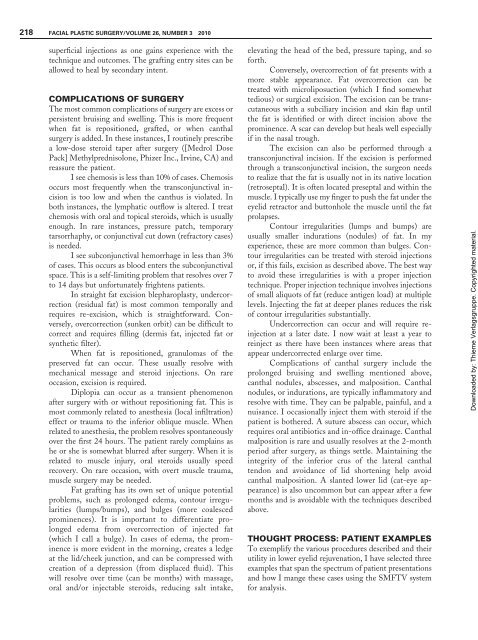Comprehensive Lower Eyelid Rejuvenation - Dr. Guy Massry
Comprehensive Lower Eyelid Rejuvenation - Dr. Guy Massry
Comprehensive Lower Eyelid Rejuvenation - Dr. Guy Massry
Create successful ePaper yourself
Turn your PDF publications into a flip-book with our unique Google optimized e-Paper software.
218 FACIAL PLASTIC SURGERY/VOLUME 26, NUMBER 3 2010<br />
superficial injections as one gains experience with the<br />
technique and outcomes. The grafting entry sites can be<br />
allowed to heal by secondary intent.<br />
COMPLICATIONS OF SURGERY<br />
The most common complications of surgery are excess or<br />
persistent bruising and swelling. This is more frequent<br />
when fat is repositioned, grafted, or when canthal<br />
surgery is added. In these instances, I routinely prescribe<br />
a low-dose steroid taper after surgery ([Medrol Dose<br />
Pack] Methylprednisolone, Phizer Inc., Irvine, CA) and<br />
reassure the patient.<br />
I see chemosis is less than 10% of cases. Chemosis<br />
occurs most frequently when the transconjunctival incision<br />
is too low and when the canthus is violated. In<br />
both instances, the lymphatic outflow is altered. I treat<br />
chemosis with oral and topical steroids, which is usually<br />
enough. In rare instances, pressure patch, temporary<br />
tarsorrhaphy, or conjunctival cut down (refractory cases)<br />
is needed.<br />
I see subconjunctival hemorrhage in less than 3%<br />
of cases. This occurs as blood enters the subconjunctival<br />
space. This is a self-limiting problem that resolves over 7<br />
to 14 days but unfortunately frightens patients.<br />
In straight fat excision blepharoplasty, undercorrection<br />
(residual fat) is most common temporally and<br />
requires re-excision, which is straightforward. Conversely,<br />
overcorrection (sunken orbit) can be difficult to<br />
correct and requires filling (dermis fat, injected fat or<br />
synthetic filter).<br />
When fat is repositioned, granulomas of the<br />
preserved fat can occur. These usually resolve with<br />
mechanical message and steroid injections. On rare<br />
occasion, excision is required.<br />
Diplopia can occur as a transient phenomenon<br />
after surgery with or without repositioning fat. This is<br />
most commonly related to anesthesia (local infiltration)<br />
effect or trauma to the inferior oblique muscle. When<br />
related to anesthesia, the problem resolves spontaneously<br />
over the first 24 hours. The patient rarely complains as<br />
he or she is somewhat blurred after surgery. When it is<br />
related to muscle injury, oral steroids usually speed<br />
recovery. On rare occasion, with overt muscle trauma,<br />
muscle surgery may be needed.<br />
Fat grafting has its own set of unique potential<br />
problems, such as prolonged edema, contour irregularities<br />
(lumps/bumps), and bulges (more coalesced<br />
prominences). It is important to differentiate prolonged<br />
edema from overcorrection of injected fat<br />
(which I call a bulge). In cases of edema, the prominence<br />
is more evident in the morning, creates a ledge<br />
at the lid/cheek junction, and can be compressed with<br />
creation of a depression (from displaced fluid). This<br />
will resolve over time (can be months) with massage,<br />
oral and/or injectable steroids, reducing salt intake,<br />
elevating the head of the bed, pressure taping, and so<br />
forth.<br />
Conversely, overcorrection of fat presents with a<br />
more stable appearance. Fat overcorrection can be<br />
treated with microliposuction (which I find somewhat<br />
tedious) or surgical excision. The excision can be transcutaneous<br />
with a subciliary incision and skin flap until<br />
the fat is identified or with direct incision above the<br />
prominence. A scar can develop but heals well especially<br />
if in the nasal trough.<br />
The excision can also be performed through a<br />
transconjunctival incision. If the excision is performed<br />
through a transconjunctival incision, the surgeon needs<br />
to realize that the fat is usually not in its native location<br />
(retroseptal). It is often located preseptal and within the<br />
muscle. I typically use my finger to push the fat under the<br />
eyelid retractor and buttonhole the muscle until the fat<br />
prolapses.<br />
Contour irregularities (lumps and bumps) are<br />
usually smaller indurations (nodules) of fat. In my<br />
experience, these are more common than bulges. Contour<br />
irregularities can be treated with steroid injections<br />
or, if this fails, excision as described above. The best way<br />
to avoid these irregularities is with a proper injection<br />
technique. Proper injection technique involves injections<br />
of small aliquots of fat (reduce antigen load) at multiple<br />
levels. Injecting the fat at deeper planes reduces the risk<br />
of contour irregularities substantially.<br />
Undercorrection can occur and will require reinjection<br />
at a later date. I now wait at least a year to<br />
reinject as there have been instances where areas that<br />
appear undercorrected enlarge over time.<br />
Complications of canthal surgery include the<br />
prolonged bruising and swelling mentioned above,<br />
canthal nodules, abscesses, and malposition. Canthal<br />
nodules, or indurations, are typically inflammatory and<br />
resolve with time. They can be palpable, painful, and a<br />
nuisance. I occasionally inject them with steroid if the<br />
patient is bothered. A suture abscess can occur, which<br />
requires oral antibiotics and in-office drainage. Canthal<br />
malposition is rare and usually resolves at the 2-month<br />
period after surgery, as things settle. Maintaining the<br />
integrity of the inferior crus of the lateral canthal<br />
tendon and avoidance of lid shortening help avoid<br />
canthal malposition. A slanted lower lid (cat-eye appearance)<br />
is also uncommon but can appear after a few<br />
months and is avoidable with the techniques described<br />
above.<br />
THOUGHT PROCESS: PATIENT EXAMPLES<br />
To exemplify the various procedures described and their<br />
utility in lower eyelid rejuvenation, I have selected three<br />
examples that span the spectrum of patient presentations<br />
and how I mange these cases using the SMFTV system<br />
for analysis.<br />
Downloaded by: Thieme Verlagsgruppe. Copyrighted material.


